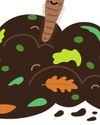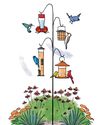Prøve GULL - Gratis
Red-Hot Plants
Birds & Blooms
|October/November 2024
Scarlet-hued berries add a pop of color to any garden

1 Strawberry tree
ARBUTUS UNEDO
ZONES 7 TO 10
This slow-growing evergreen shrub or small tree is native to western Europe and thrives in warmer climates. The glossy leaves, white flowers, and red berries or drupes provide interest in every season. Harvest the fruit in autumn and use it in jams and jellies. Be careful: It bruises easily.
Why we love it: Pollinators enjoy the nectar, and small mammals and birds are attracted to the high sugar content in the fruit.
 2 Bunchberry
2 Bunchberry CORNUS CANADENSIS
ZONES 2 TO 6
Common in forests throughout Canada and the northern United States, this spreading ground cover is a great choice for gardens in cool climates. Features include glossy green leaves that transition to red and purple in the fall and small white flowers that give way to clusters of berrylike drupes that ripen in August and last until fall.
Why we love it: Rabbits and deer steer clear of this plant.
 3 Lingonberry
3 Lingonberry VACCINIUM VITIS-IDAEA
ZONES 2 TO 7
This creeping evergreen shrub forms dense mats, but it's not the leatherlike oval leaves that make it popular; it's the red edible berries that appear twice a year. Eaten raw, the fruits have a bitter taste, but they make an ideal replacement for cranberries when cooked (hence the alternate moniker, northern mountain cranberries).
Why we love it: Lingonberries are superfruits and have the highest antioxidant content of all berries.
Denne historien er fra October/November 2024-utgaven av Birds & Blooms.
Abonner på Magzter GOLD for å få tilgang til tusenvis av kuraterte premiumhistorier og over 9000 magasiner og aviser.
Allerede abonnent? Logg på
FLERE HISTORIER FRA Birds & Blooms

Birds & Blooms
Better Off with Bats
Rethink the unsung heroes of the night and why you should support them
2 mins
October / November 2025

Birds & Blooms
Late Bloomers to Love
Keep garden colors going strong with fall perennials
3 mins
October / November 2025

Birds & Blooms
IN THE COMPANY OF OWLS
On any given morning, you'll find A.J. Berard trekking through the woods and mountains of Montana with a 45-pound pack and his Siberian huskies.
3 mins
October / November 2025

Birds & Blooms
Tree TLC
Discover tips for planting and tending to trees, from the roots up
2 mins
October / November 2025

Birds & Blooms
EASY. BREEZY Black-Eyed Susans
Planting rudbeckia, with petals aglow in honeyed yellow, fiery orange and velvety burgundy, is like sprinkling sunshine throughout the garden.
3 mins
October / November 2025

Birds & Blooms
Social and Adaptable
Find out how the house finch became a backyard regular
1 mins
October / November 2025

Birds & Blooms
Tales from the UNDERSTORY
The dense forest floor is the perfect setting to nest and forage
3 mins
October / November 2025
Birds & Blooms
Tracking Tiny Travelers
Small, numbered rings reveal the secrets of hummingbird migration
2 mins
June/July 2025

Birds & Blooms
The Dirt on Millicompost
Learn how to use millipedes to increase soil health
2 mins
June/July 2025

Birds & Blooms
THE PERFECT PAIRING
Learn the best ways to use an abundance of blooms to attract more birds and beautify your feeder space
3 mins
June/July 2025
Listen
Translate
Change font size
